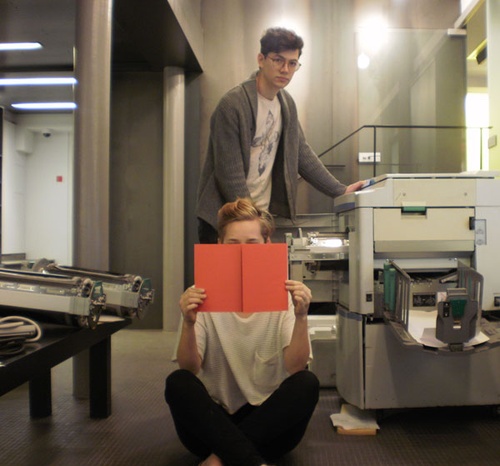
Pop Montreal 2010: Palimpsest Loves Print
Palimpsest's Danielle St-Amour on the magazine-in-a-box's daily Pop newspaper.
Danielle St-Amour, bottom, with Palimpsest collective member Willie Brisco at the DHC.
Palimpsest magazine is part publication and part time capsule, a search engine in a shoebox. In the age of the beginning of the end of print it worships the physical relentlessly, far beyond the charge of mere Ludditism; Palimpsest loves the internet too, for all it has done to mould us. For this year's edition of Pop Montreal, the brains behind Palimpsest will produce a daily newspaper documenting the festival's goings-on, but don't expect a mere newsletter. Here, collective member Danielle St-Amour talks Pop, print and personal music journalism.
Drew Nelles: What can you tell me about the Pop newspaper?
Danielle St-Amour: The newspaper is going to be printed out of the DHC in the Old Port. We have about eight contributors right now, with the aim of doing some music journalism without the typical super-personalized avenues it usually takes. It's going to be printed on a Risograph machine—two eleven-by-fourteen broadsheets, double-sided. The majority of the content seems to be leaning towards straight data collection right now. We have one girl who is doing stats on bands—she's going to do live decibel sound recordings, and then we'll publish that data like a business column, down the side.
DN: What do you mean when you say you want to avoid "hyper-personalized" music journalism?
DSA: I think the majority of music journalism seems to be a direct, critical, personal response to the show—"I liked the band, they met my expectations in this way, they did not meet my expectations in this way." There are so many places to receive that kind of information during the festival. When we were asked to do this, we tried to figure out ways to do it without having yet another piece about the music festival written from this first-person perspective.
DN: Why did you choose to do this in print?
DSA: Because we're a printed magazine, and because we all have a bit of a paper fetish, I think. We are also going to be doing it as a PDF that will come out at the end of the festival, but we wanted to create a daily paper, and the odds of people looking at a daily on the internet for the duration of a festival that runs from morning to night is really unlikely.
To situate ourselves in a place like the DHC we needed to incorporate a performative element, and making a PDF isn't the most exciting thing for people to watch. So we got our hands on the Risograph, which is really amazing—basically a silkscreening machine—and we decided to do it that way.
DN: It seems like Palimpsest has—not an ambivalent relationship, as such, but maybe a complicated relationship with the internet. On the one hand you host YouTube-themed art shows, but you also openly describe yourselves as print fetishists. Can you speak to that?
DSA: When we first started talking about making Palimpsest, we thought we'd make a rotating web gallery and then collect from that. So all the presentation would be done initially in this web gallery, and then we'd select things with a theme in mind and create a physical package to be sent out once a year. But it turned out to be easier to do things the other way around.
I think we're trying to find a place where we can sit in the middle, because we know it's important as a publication to have a web presence. In order to be able to present this one thing we do, which is the magazine, we need to have a localized place where people can see all the other things that we're interested in.
DN: I was also thinking that the format you decided to publish Palimpsest in is a challenge to traditional print media in its own way, and a response to its slow dissolution, because it's defiant of binding, defiant of how we conceive of printed publications in general.
DSA: I think the only thing that's really defiant about it is that we tacked the word "magazine" on the end. It's coming from a somewhat long tradition of alternative packages; we were referring to Aspen magazine, BLAST. It's happened a lot. For all intents and purposes we are a magazine, and I think Tess [Edmonson] did a really good job of delineating that in the editorial introduction to the first issue—she talks about what a magazine has been historically, and where we fit in those categories. I don't know if there's anything really defiant about it. It's a step to the side of art publishing and a step to the side of magazine publishing.
DN: I like the idea of doing an actual daily production, but it's going to be such a drain on you guys. How are you going to be able to enjoy the festival?
DSA: I don't think I was going to be able to enjoy it anyways, because we're also doing a bookfair, but I don't think it'll be that bad. We have a template set up and hopefully all the information will be plugged in around noon or one, and the Risograph does all the printing for us. And we have volunteers who are going to cart it up to the neighbourhood and distribute it. And hopefully we'll have enough people folding. If you want to come help with folding...
DN: [Noncommittal pause] Maybe.
Related on maisonneuve.org:
—Pop Montreal 2010: Maisy's Picks
—Pop Montreal: Interview With Patricia Boushel
—Interview With Sean Michaels
Subscribe — Follow Maisy on Twitter — Like Maisy on Facebook





